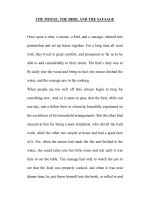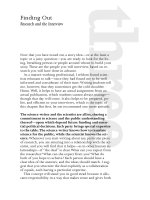Bioethics and the clinician-researcher divide
Bạn đang xem bản rút gọn của tài liệu. Xem và tải ngay bản đầy đủ của tài liệu tại đây (160.59 KB, 11 trang )
Chapter
18
Bioethics and the
clinician/researcher divide
Almosteveryonecanandshoulddo research...because almost everyonehasaunique
observational opportunity at some time in his life which he has an obligation to
record...Ifone considers the fundamental operations ormethods of research, one
immediately realizes that most people do research at some time or another, except
that they do not call their activity by that name.
John Cade (Cade, 1971)
An underlying theme of this book is that one cannot be a good clinician unless one under-
stands research. I also believe the opposite holds for clinical research: one cannot be a good
clinical researcher unless one is an active clinician.
e divide that exists between the world of clinical practice and the world of research is
partlytheresultoflackofknowledge;themainpurposeofthisbookistoredressthatlackof
knowledge on the part of clinicians. But partly also the divide is widened due to biases and,
in my view, a mistaken approach, by the mainstream bioethics community, to the ethics of
research.
e biases of some non-researchers toward clinical research became clear to me in one
of my academic positions. A leader in our department was a prominent psychoanalyst, an
active clinician who had never conducted research. He was convinced that any research
activity must, by that mere fact, be ethically suspect. is is because clinical work is done
in the interests of the patient, while research is done in the interests of knowledge (society,
science; not the individual patient). is is the basic belief of mainstream bioethics, enforced
daily by the institutional review boards of all academic centers, and policed by the federal
government.
Yet if John Cade was right, then something is awry, and the problem of clinical innovation
highlights the matter.
Clinical innovation
Most clinicians, researchers, and ethicists would agree that it is important to expand medical
knowledge, and thus, at a very basic level, it is ethical to engage in research, given appropriate
protections for research subjects. As a corollary, one might argue that it is unethical not to
do research. We must, as a result, constantly be aware of the need to balance the risk of being
ignorant versus the risks involved in obtaining new knowledge. Too oen, this debate is one-
sided,focusedontherisksinvolvedinobtainingnewknowledge.Buttherearerisksonboth
sides of the ledger, and not doing research poses real risks also. Hence the importance of
assessing the merits of clinical innovation, which I believe is a legitimate component of the
research process.
Section 6: The politics of statistics
Virtuallyeverythingthatgetstoclinicaltrialscomesfromearlyclinicalinnovation.
Conceived in terms used by evidence-based medicine (EBM), innovation in psychophar-
macology more commonly proceeds bottom-up, rather than top-down (Table 3.1). Inno-
vation proceeds usually from level V case reports, through levels III–IV naturalistic and
non-randomized studies, to levels I–II randomized studies.
Clinical innovation occurs, by denition, outside of formal research protocols. ere is
a risk that guidelines of any kind, however well-intentioned, will impede clinical innovation
unnecessarily. On the other hand, there are limits to acceptable innovation, and in some cases,
one can imagine cases of innovation that would appear to be unethical.
The Belmont Report
Part of the problem is that the bioethics community has sought to cleanly and completely
separate clinical practice from research. In the Belmont Report of e National Commission
for the Protection of Human Subjects (National Institute of Health, 1979), for instance, an
attempt was made to separate “practice,” where “interventions are designed solely to enhance
the wellbeing of an individual patient or client and that have a reasonable expectation of suc-
cess,” from “research,” dened as “an activity designed to test an hypothesis, permit conclu-
sions to be drawn, and thereby to develop or contribute to generalizable knowledge.” In fact,
the clinician/researcher engaging in clinical innovation is not acting with solely one set of
interests in mind, but two. On the one hand, the clinician/researcher wants to help the indi-
vidual patient; on the other hand, the clinician/researcher wants to gain some experience or
knowledge from his/her observation.Some in the bioethics community set up this scenario as
a necessary conict. ey seem to think that a choice must be made: either the clinician must
choose to seek only to make the patient better, without learning anything in the process, or the
clinician must seek to learn something, without any intention at all to improve the patient’s
lot. As with so much in life, there are in fact multiple interests here and there is no need to
insist that those interests do not overlap at all. First and foremost in any clinical encounter
is the clinician’s responsibility to the individual welfare of the patient. Any innovative treat-
ment, observation, or hypothesis cannot be allowed to lead to complete lack of regard for the
patient’s welfare. Unfortunately, the Belmont Report and much of the mainstream bioethics
literature presumes complete and unavoidable conict of these interests: “When a clinician
departs in a signicant way from standard or accepted practice, the innnovation does not, in
and of itself, constitute research. e fact that a procedure is ‘experimental’, in the sense of
new,untested,ordierent,doesnotautomaticallyplaceitinthecategoryofresearch...[but]
the general rule is that if there is any element of research in an activity, that activity should
undergo review for the protection of human subjects.”
is approach leads, in my view, to uncontrolled clinical innovation and overregulated
formal research. e ultimate rationale for clinical innovation lies in the history of the many
serendipitous discoveries of medical practice. Psychopharmacology is full of such stories,
Cade’s discovery of lithium being perhaps the paradigm case.
Cade’s discovery of lithium
In the 1940s, John Cade hypothesized that mania and depression represented abnormal-
ities of nitrogen metabolism. He injected urine samples from psychiatric patients into guinea
pigs, all of whom died. He concluded that the nitrogenous product, urea, was probably
128
Chapter 18: Bioethics
acting as a poison, and later tested uric acid solubilized as lithium urate, which led to marked
calming of the guinea pigs. Further tests identied lithium to be the calming agent, and Cade
then proceeded to try lithium himself before giving it to patients. His rst patient improved
markedly, but then experienced toxicity and died aer a year. Cade was quite concerned and
abandoned using lithium further due to its toxicity, but reported his ndings in detail. Other
researchers, in the rst randomized clinical trials (RCTs) in psychiatry, proved lithium safe
and eective at non-toxic levels.
Would we have lithium if Cade were working today? It is unlikely.
It is striking that there is a double standard here: attempts to expand knowledge that are
labeled “research” receive intense scrutiny, whereas clinical innovation receives no scrutiny at
all. One researcher commented that if he wanted to give a new drug to half of his patients (in
an RCT), he would need to go through miles of administrative ethical hoops, but if he wanted
to give a new drug to all of his patients, nothing stood in his way. Something is wrong with
this scenario.
Trivial research, thoughtless practice
At the National Institute of Mental Health (NIMH), research funding has been divided
between “intramural” and “extramural” types. Extramural research required extensive over-
sight into scientic utility. Intramural research did not require such oversight and was
designed to encourage innovative ideas. In the terminology of Steve Brodie, an icon of Nobel-
prize level psychiatric research, intramural research allowed investigators to “take a ier” on
new ideas (Kanigel, 1986). Unfortunately, now intramural research at the NIMH requires
extramural-like levels of scientic oversight and justication. As a result, both inside the
NIMH and outside psychiatric research is more and more comprised of increasing pristine
presentations of increasingly trivial points (Ghaemi and Goodwin, 2007).
e NIMH has also tended to avoid funding of clinical psychopharmacology research on
the grounds that a source of funds exists in private industry; the limitations of that attitude
are now well known (see Chapter 17).
Some will argue that my discussion of clinical innovation here conicts with federal stan-
dards, such as the Belmont Report, which has been identied by the National Institutes of
Health (NIH) Oce of Human Subjects Research as the philosophical foundation for its eth-
ical regulations (Forster, 1979). Aer all, we have to follow the law.
As mentioned above, the Report leaves itself open to a strict interpretation when it
asserts that “any element of research” requires formal review. However, the Report also
establishes three fundamental ethical principles that are relevant to all research involving
human subjects: respect for persons, benecence, and justice. One could argue that the sta-
tus quo, by overregulating research and ignoring clinical practice, is not in keeping with the
principles underlying the Belmont Report. Even the NIH notes that the Report is “not a set
of rules that can be applied rigidly to make determinations of whether a proposed research
activity is ethically ‘right’ or ‘wrong.’ Rather, these regulations provide a framework in which
investigators and others can ensure that serious eorts have been made to protect the rights
and welfare of research subjects.”
I think the best research is conducted by active clinicians, and that the best clinical work
is conducted by active researchers. e strict wall separating pure research from pure clinical
practice is at best a ction, and at worst a dumbing down of both activities. A change in some
of the basic axioms of the eld of research ethics may be needed so that we can avoid the
129
Section 6: The politics of statistics
alternative extremes of indiscriminate clinical practice on the one hand and overregulation
of all research on the other.
A coda by A. Bradford Hill
It may be tting to end this book by letting A. Bradford Hill again speak to us, now on this
topic of so great concern to him: bringing clinicians and researchers together, combining
medicine and statistics. He saw room for both statisticians and clinicians to learn to come
together (Hill, 1962; pp. 31–2):
In my indictment of the statistician, I would argue that he may tend to be a trie too
scornful of the clinical judgment, the clinical impression. Such judgments are, I
believe, in essence, statistical. e clinician is attempting to make a comparison
between the situation that faces him at the moment and a mentally recorded but
otherwiseuntabulated past experience...Turning now to the othersideofthe
picture – the attitude of the clinician – I would, from experience, say that the most
frequent and the most foolish criticism of the statistical approach in medicine is that
human beings are too variable to allow of the contrasts inherent in a controlled trial of
a remedy. In other words, each patient is ‘unique’ and so there can be nothing for the
statisticiantocount.Butifthisistrueithasalwaysseemedtomethatthebottomfalls
out of the clinical approach as well as the statistical. If each patient is unique, how can
a basis for treatment be found in the past observations of other patients?
Hill goes on to note that each patient is not totally unique from another patient, but many
variable features dier among patients. is produces, through confounding bias, the messy
result of unscientic medicine, full of competing opinions and observations:
Two or three uncontrolled observations may, therefore, give merely through the
customary play of chance, a favourable picture in the hands of one doctor, an
unfavourable picture in the hands of a second. And so the medical journals,
euphemistically called the ‘literature’, are cluttered up with conicting claims – each in
itself perfectly true of what the doctor saw, and each insucient to bear the weight of
the generalization placed upon it. Far, therefore, from arguing that the statistical
approach is impossible in the face of human variability, we should realize that it is
becauseofthatvariabilitythatitisoenessential.
e sum of it all is this: one cannot be a good clinician unless one is a good researcher,
and one cannot be a good researcher unless one is a good clinician. Good clinical practice
shares all the features of good research: careful observation, attention to bias and chance,
replication, reasoned inference of causation.
We are still in limbo, “until that happy day arrives when every clinician is his own statisti-
cian,” as Hill put it (Hill, 1962; p. 30), but we will never reach that day until we become aware
that medicine without statistics is quackery, and statistics without medicine is numerology.
130
Appendix: Regression models and
multivariable analysis
Assumptions of regression models
e use of regression models involves some layers of complexity beyond those discussed in
the text. To recapitulate: “Multivariable analysis is a statistical tool for determining the unique
contributions of various factors to a single event or outcome.” (Katz, 2003.) Its rationale is
that one cannot answer all questions with randomized studies: “In many clinical situations,
experimental manipulation of study groups would be unfeasible, unethical, or impracti-
cal...For example, we cannot test whether smoking increases the likelihood of coronary
artery disease by randomly assigning persons to groupswho smoke and do not smoke.” (Katz,
2003.)
e rationale and benets of multivariable regression are clear, but it too has limita-
tions. ere are three types of regression: linear (for continuous outcomes, such as change in
depression rating scale score), logistic (for dichotomous outcomes, such as being a responder
or not), and Cox (for time to event outcomes, as in survival analysis).
In linear regression, there is an assumption “that, as the independent variables increase
(or decrease), the mean value of the outcome increases (or decreases) in linear fashion.”
(Katz, 2003.) Non-linear relationships would not be accurately captured in a regression
model; sometimes statisticians will “transform” the variables with logarithmic or other
changes to the regression equation, so as to convert a non-linear relationship between the
outcome and the predictors to a linear relationship. is is not inherently problematic, but it
is complex and it involves changing the data more and more from their original presentation.
Sometimes these transformations still fail to create a linear relationship, and in such cases,
the non-linear reality cannot be captured with standard linear regression models.
In logistic regression, “the basic assumption is that each one-unit increase in a predictor
multipliestheoddsoftheoutcomebyacertainfactor(theoddsratioofthepredictor)andthat
the eect of several variables is the multiplicative product of their individual eects.” (Katz,
2003.) If the combined eect of several variables is additive or exponential, rather than simply
multiplicative, the logistic regression model will not accurately capture that relationship of
those several variables to the outcome.
In Cox regression, there is a proportionality assumption: “the ratio of the hazard functions
for persons with and without a given risk factor is the same over the entire study period.”
(Katz, 2003.) is means that two groups – say one who receives antidepressants and one who
does not – would dier in a constant amount in risk of relapse over a period of study. Let us
stipulate that in a one year study, the risk of relapse o antidepressant increases exponentially
overtime,sothatitisratherlowinitiallyandquitehighatmonths11and12.Sincethisrisk
of relapse is not a constant slope, it would violate the proportionality assumption, and thus
estimates of relative risk compared to another group on antidepressants would not be fully
accurate. is problem can be addressed statistically by the use of “time-varying covariate”
analyses.
Another problem in Cox regression, less amenable to statistical correction, is the assump-
tion that “censored persons have had the same course (as if they had not been censored) as









